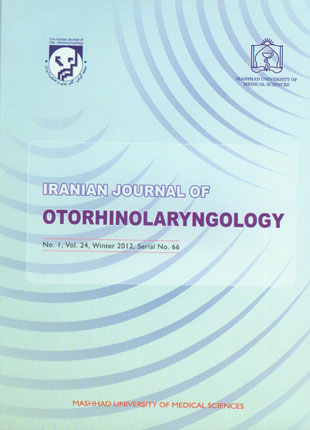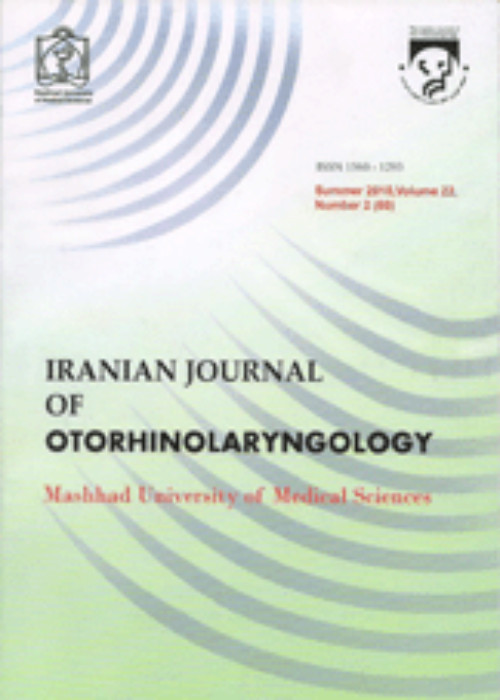فهرست مطالب

Iranian Journal of Otorhinolaryngology
Volume:24 Issue: 1, Winter2012
- 50 صفحه،
- تاریخ انتشار: 1390/11/05
- تعداد عناوین: 8
-
-
Pages 7-14IntroductionCochlear implantation can facilitate the development of communication skills in children with profound hearing loss. The objectives of our study were to determine the average ages at suspicion and diagnosis of hearing loss, amplification, intervention, and performance of cochlear implantation and to investigate the effects of the parents’ level of education and economic circumstances on the age of the child at cochlear implantation.Materials And MethodsThe parents of 96 children with profound sensorineural hearing loss who had received a cochlear implant at AmirAlam Cochlear Implant Center between 2008 and 2010 were asked to complete a survey. The survey included demographic information, and birth, medical, and hearing loss history of their child. Study data were obtained through the patient database in the Cochlear Implant Center and interviews with the parents.ResultsThe mean times between the age of the children at diagnosis of hearing loss and amplification, beginning the rehabilitation program, and performing the cochlear implantation were 4.05 (±0.86), 2.59 (±0.9), and 25.43 (±1.45) months, respectively; delays that were statistically significant (P≤0.004). In 47.9 percent of cases, the parents were the first people to suspect the occurrence of hearing loss in their child. Statistical analysis indicated that the age at cochlear implantation decreases as the educational level of the parents increases (P≤0.003). There was also a significant difference between parents’ economic circumstances and the age of cochlear implantation (P<0.0001).ConclusionThere is still a remarkable delay between the diagnosis of hearing loss and aural rehabilitation in hearing-impaired children. Parents’ levels of education and economic circumstances have a noticeable effect on the age of cochlear implantation in hearing-impaired children.
-
Pages 15-18IntroductionOne of the main treatments of chronic otitis media with effusion is ventilation of the middle ear with a ventilation tube (VT). The objective of this study was to determine the incidence and the types of VT complications in children with otitis media with effusion in Ahvaz.Materials And MethodsIn this prospective study, the medical records of 208 children (52 male and 35 female) in Imam Khomeini and Apadana hospitals were reviewed. The children were between 10 months and 6 years old. The patients were followed up 12-18 months after ventilation tube insertion. We reviewed age, sex, postoperative otorrhea, eardrum atrophy, tympanosclerosis and persistent perforation. In all these patients, the indication for surgery was chronic middle ear effusion. The data were analyzed and presented as numbers and percentages using SPSS17.0.ResultsTransient otorrhea occurred in 12.5% and delayed otorrhea in 8.2%. Otorrhea non-responsive to medical treatment was seen in 1.9%. Complications after tympanostomy tube extrusion included atrophy (27.8%) myringosclerosis (37.9%), and persistent perforation (2.4%).The average extrusion time was 10.5 ±5 months (ranging between 3-22 months).ConclusionAfter extrusion of the ventilation tube, patients should be followed up regularly for recurrence of OME. Myringosclerosis, tympanic membrane atrophy and otorrhea are the most common complications of otitis media with effusion. However, they are generally insignificant. Consequently, in the majority of these complications, there is no need for any treatment.
-
Pages 19-22IntroductionSudden sensorineural hearing loss (SSNHL) is a true emergency that must be diagnosed and treated immediately. The purpose of this study is to compare the efficacy of treatment with intratympanic dexamethasone plus oral prednisolone daily or every other day with that of treatment with oral prednisolone alone.Materials And MethodsSixty-three patients with SSNHL that had been present for less than 10 days prior to the start of treatment were randomly allocated to three different groups. Patients in group A were treated daily with oral prednisolone 1 mg/kg for 10 days plus intratympanic dexamethasone 2 mg for the first 3 days of treatment. Patients in group B were treated every other day with oral prednisolone 1 mg/kg for 10 days with the addition of intratympanic dexamethasone 2 mg for the first 3 treatments. Patients in group C were treated daily with oral prednisolone 1 mg/kg alone for 10 days. Audiometric parameters including pure tone audiometry (PTA), speech reception threshold (SRT), and speech discrimination score (SDS) were assessed on days 1,5, and 10.ResultsThere was a significant improvement in PTA, SRT and SDS in each group over the 10 days but the greatest improvement was seen in the SRT measurements of group A in comparison with group B (19.81 ± 2.15, P=0.04) and C (26.26 ± 0.08, P=0.01). The difference in SRT between groups B and C was not statistically significant.ConclusionThe administration of intratympanic dexamethasone 2 mg daily for 3 days has an additive effect to that of 10 days of oral prednisolone 1 mg/kg in the treatment of SSNHL.
-
Pages 23-28IntroductionTonsillectomy is one of the most common surgical operations and has such complications as pain, hemorrhage and laryngospasm. Pain management is of vital importance in order to reduce the suffering and restlessness in children having undergone tonsillectomy. Different studies differ in their findings as to the use of ketamine for postoperative analgesia. The aim of this study was to investigate the effect of peritonsillar injection of ketamine preoperatively on postoperative pain relief.Materials And MethodsThis was a randomized controlled trial (RCT) on sixty 3-12-year-old children. Children were randomly assigned to the intervention and control groups. Peritonsillar injection consisted of 1 mg/kg ketamine in the intervention group and of normal saline in the control group. An injection of 1 cc was administered on each side five minutes prior to tonsillectomy. Pain assessment was performed using the self-report Oucher Scale and CHEOPS (Children's Hospital of Eastern Ontario Pain Scale) and sedative state assessment was performed using the Wilson Sedation Scale. Pain, medication and complications were studied for 24 hours. Data analysis was performed using chi-squared test and t-test.ResultsThe ketamine group had a lower pain score compared with the control group (1.40±1.003 compared with 1.53±1.074). The average pain was less in the control group two hours after the surgery. The difference was statistically significant. There was no difference between the two groups in terms of nausea and vomiting incidence.ConclusionThe peritonsillar injection of ketamine five minutes prior to the surgery reduces the post-tonsillectomy pain without causing any complications.
-
Pages 29-33IntroductionThere are suspended fungal spores in the air and in the nasal mucosa of adults, especially in areas with a humid climate. Several studies have revealed the role of fungi in the pathogenesis of chronic rhinosinusitis (CRS) in recent years but it is a topic of controversy, especially in regions with low humidity. The aim of this study was to evaluate the prevalence of fungal species in intraoperative specimens from patients who underwent functional endoscopic sinus surgery (FESS) for CRS in Hamadan, a high altitude region of Iran.Materials And MethodsIn this prospective cross-sectional study specimens were obtained from 62 patients with a diagnosis of CRS according to clinical and computed tomography criteria who underwent endoscopic sinus surgery. During the functional endoscopic sinus surgery, specimens were collected from the nose and sinuses of patients and preserved in conical centrifuge tubes containing Sputolysin and chloramphenicol. The specimens were then plated on Sabouraud dextrose agar, Mycosel agar, Niger seed agar, and Chrom Agar/Candida plates and incubated at 30°C for up to 1 month. At the end of the incubation period the samples were evaluated microscopically to detect fungi and identify their genera and species.ResultsThe fungal cultures were positive in 16 out of 62 patients with CRS (25.8%). In order of frequency the fungal genera and species were: Aspergillus fumigatus (9), Aspergillus niger (3), Candida albicans (2), Penicillium sp. (1) and Cladosporium sp. (1). The percentage of positive cultures collected was higher in winter but the difference was not statistically significant compared to the rest of the year.ConclusionOur data show that 25.8% of patients tested positive for the presence of fungi. The results strengthen the theory regarding the role of fungi in the pathogenesis of CRS even in areas with low humidity. Aspergillus was the most commonly isolated fungus.
-
Pages 35-40IntroductionThe hallmark of vitiligo is the disappearance of melanocytes from the skin due to an as yet unidentified mechanism. The presence of melanocytes in the auditory apparatus suggests that this system could possibly be affected by vitiligo, which targets the melanocytes of the whole body and not just the skin. The purpose of this study was to assess the incidence of auditory alterations in patients with vitiligoMaterials And MethodsA total of 21 patients diagnosed with vitiligo were enrolled in this study. A group of 20 healthy subjects served as a control group. Pure tone audiometry (PTA) and measurements of auditory brain stem responses (ABR) were carried out in all participants.ResultsHigh frequency sensory neural hearing loss was detected in 8 patients (38.09%). Analysis of ABR revealed that 10 patients (47.61%) had an abnormal increase in the latency of Wave III and 6 (28.57%) had an abnormal prolongation of the inter peak latency between Wave I and III. There was no correlation between age, duration of disease, and any of the recorded parameters.ConclusionThis study highlights the involvement of the auditory system in patients with vitiligo, suggesting that vitiligo is a systemic disease rather than a purely cutaneous problem.
-
Pages 41-44IntroductionLobular capillary hemangioma (LCH) is a benign lesion of vascular origin. It rarely involves nasal cavity which most commonly manifests as progressive nasal obstruction and epistaxis. Case Report: In this report we present a case of LCH of the nasal cavity which occurred approximately one month after delivery. There was no recurrence after complete endoscopic resection during one year follow up.
-
Pages 45-50IntroductionNager syndrome is a malformation resulting from problems in the development of the first and second branchial arches and limb buds. The cause of the abnormal development of the pharyngeal arches in Nager syndrome is unknown. It is also unclear why affected individuals have bone abnormalities in their arms and legs. Nager syndrome is thought to have an autosomal recessive inheritance pattern when unaffected parents have more than one affected child. The purpose of this report is to present a case of Nager syndrome where the patient exhibited upper limb shortening, an unusual feature that has been reported as coexisting in some individuals with Nager syndrome. Case report: A 3.5-year-old girl was referred to our Department of Pediatric Otorhinolaryngology due to a cleft palate. Her craniofacial anomalies included malar hypoplasia, severe mandibular hypoplasia with retrognathia, downward slanted palpebral fissures, a high narrow hard palate, absent soft palate, small retroplaced tongue, bilateral external auditory canal atresia, and dysplastic ears. There was no evidence of mental retardation. Based on the craniofacial characteristics and the coexisting upper limb preaxial anomalies, a diagnosis of Nager syndrome was confirmed.ConclusionNager syndrome is a rare disorder resulting from developmental abnormalities of the first and second branchial arches. It is linked to five other similar syndromes: Miller syndrome, Treacher-Collins, Pierre-Robin, Genee-Wiedemann, and Franceschetti-Zwahlen-Klein. Multidisciplinary management by a craniofacial team is needed. Early intervention, intensive education, new surgical techniques, and an emphasis on coordinated care have improved the quality of life in this patient with Nager syndrome.


